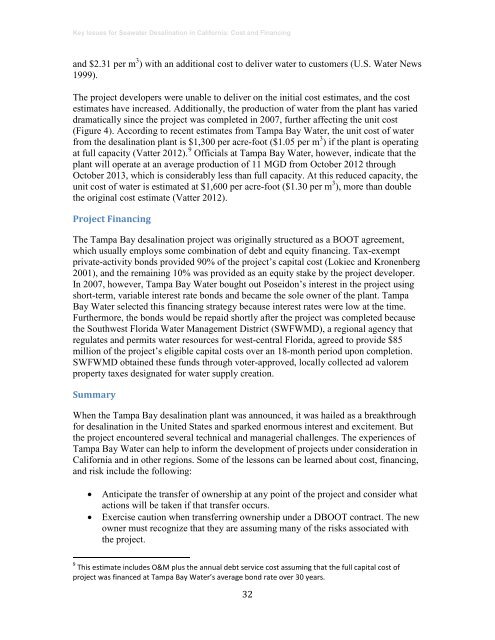997.4 KB - San Francisco Bay Area Independent Media Center
997.4 KB - San Francisco Bay Area Independent Media Center
997.4 KB - San Francisco Bay Area Independent Media Center
You also want an ePaper? Increase the reach of your titles
YUMPU automatically turns print PDFs into web optimized ePapers that Google loves.
Key Issues for Seawater Desalination in California: Cost and Financing<br />
and $2.31 per m 3 ) with an additional cost to deliver water to customers (U.S. Water News<br />
1999).<br />
The project developers were unable to deliver on the initial cost estimates, and the cost<br />
estimates have increased. Additionally, the production of water from the plant has varied<br />
dramatically since the project was completed in 2007, further affecting the unit cost<br />
(Figure 4). According to recent estimates from Tampa <strong>Bay</strong> Water, the unit cost of water<br />
from the desalination plant is $1,300 per acre-foot ($1.05 per m 3 ) if the plant is operating<br />
at full capacity (Vatter 2012). 9 Officials at Tampa <strong>Bay</strong> Water, however, indicate that the<br />
plant will operate at an average production of 11 MGD from October 2012 through<br />
October 2013, which is considerably less than full capacity. At this reduced capacity, the<br />
unit cost of water is estimated at $1,600 per acre-foot ($1.30 per m 3 ), more than double<br />
the original cost estimate (Vatter 2012).<br />
Project Financing<br />
The Tampa <strong>Bay</strong> desalination project was originally structured as a BOOT agreement,<br />
which usually employs some combination of debt and equity financing. Tax-exempt<br />
private-activity bonds provided 90% of the project’s capital cost (Lokiec and Kronenberg<br />
2001), and the remaining 10% was provided as an equity stake by the project developer.<br />
In 2007, however, Tampa <strong>Bay</strong> Water bought out Poseidon’s interest in the project using<br />
short-term, variable interest rate bonds and became the sole owner of the plant. Tampa<br />
<strong>Bay</strong> Water selected this financing strategy because interest rates were low at the time.<br />
Furthermore, the bonds would be repaid shortly after the project was completed because<br />
the Southwest Florida Water Management District (SWFWMD), a regional agency that<br />
regulates and permits water resources for west-central Florida, agreed to provide $85<br />
million of the project’s eligible capital costs over an 18-month period upon completion.<br />
SWFWMD obtained these funds through voter-approved, locally collected ad valorem<br />
property taxes designated for water supply creation.<br />
Summary<br />
When the Tampa <strong>Bay</strong> desalination plant was announced, it was hailed as a breakthrough<br />
for desalination in the United States and sparked enormous interest and excitement. But<br />
the project encountered several technical and managerial challenges. The experiences of<br />
Tampa <strong>Bay</strong> Water can help to inform the development of projects under consideration in<br />
California and in other regions. Some of the lessons can be learned about cost, financing,<br />
and risk include the following:<br />
• Anticipate the transfer of ownership at any point of the project and consider what<br />
actions will be taken if that transfer occurs.<br />
• Exercise caution when transferring ownership under a DBOOT contract. The new<br />
owner must recognize that they are assuming many of the risks associated with<br />
the project.<br />
9 This estimate includes O&M plus the annual debt service cost assuming that the full capital cost of<br />
project was financed at Tampa <strong>Bay</strong> Water’s average bond rate over 30 years.<br />
32
















